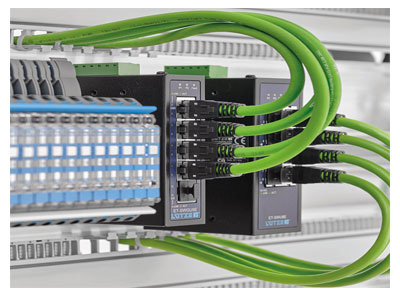Key Takeaway
The speed of Industrial Ethernet typically ranges from 10 Mbps to 1 Gbps, depending on the network setup and devices used. Most modern industrial Ethernet systems operate at 100 Mbps or 1 Gbps to support fast and reliable data transfer. This speed ensures smooth communication between machines, controllers, and sensors in real-time.
Industrial Ethernet is designed for high-speed performance even in tough conditions like vibrations, dust, or extreme temperatures. The network’s speed plays a critical role in maintaining efficiency in automation and control systems. It helps industries handle large amounts of data and meet the demands of advanced technologies like IoT and real-time monitoring.
Standard Speeds of Industrial Ethernet (10/100/1000 Mbps)
Industrial Ethernet supports three standard speeds: 10 Mbps, 100 Mbps, and 1 Gbps (1000 Mbps). Each speed serves a specific purpose, depending on the network’s size and requirements.
10 Mbps is the original Ethernet speed, suitable for simpler setups with fewer devices. It is rarely used today, as modern applications demand higher data rates. 100 Mbps is the most commonly used speed in industrial environments, balancing cost and performance. It is sufficient for most automation tasks, such as controlling machinery or monitoring equipment.
For more complex operations, 1 Gbps (Gigabit Ethernet) has become the standard. It supports large-scale networks with extensive data transfer requirements, such as those in smart factories and IoT applications. These speeds ensure that data flows seamlessly, even in demanding conditions. The choice of speed depends on the specific needs of the industry and the application.

How Industrial Ethernet Maintains High-Speed Communication
Maintaining high-speed communication in industrial environments is no small task. Industrial Ethernet ensures this through a combination of robust hardware, real-time protocols, and advanced redundancy features.
The use of high-quality cables like Cat5e and Cat6 minimizes signal loss, enabling stable communication over long distances. Additionally, industrial Ethernet switches prioritize critical data, ensuring real-time communication. This is particularly important in applications like robotic control, where even a slight delay can disrupt the entire process.
Redundancy protocols, such as Rapid Spanning Tree Protocol (RSTP), ensure that communication continues even if one link fails. These features collectively make Industrial Ethernet capable of maintaining high-speed and reliable communication, even in challenging industrial environments.
Impact of Network Architecture on Industrial Ethernet Speed
Impact of Network Architecture on Industrial Ethernet Speed
Speed Requirements for Different Industrial Applications
Different industries have varying speed requirements based on the complexity and scale of their operations. For basic applications, such as monitoring a small number of devices, 100 Mbps is typically sufficient. It ensures smooth communication without overloading the network.
In more advanced settings like smart factories, where IoT devices and real-time analytics are heavily used, 1 Gbps speeds are essential. High-speed communication allows for rapid data processing and ensures that devices like sensors, controllers, and actuators work in perfect harmony.
For large-scale industries, such as power plants or transportation systems, even higher speeds like 10-Gigabit Ethernet are becoming necessary. These applications involve massive data transfers and require ultra-low latency to maintain operational efficiency. Choosing the right speed is critical for meeting the specific demands of each application.
Future Trends in Industrial Ethernet Speeds (10-Gigabit Ethernet)
As industries embrace technologies like IoT, AI, and real-time analytics, the demand for faster communication is driving the adoption of 10-Gigabit Ethernet in industrial networks. This next-generation speed enables seamless integration of high-bandwidth applications, such as augmented reality for maintenance or advanced robotics for manufacturing.
10-Gigabit Ethernet offers ultra-low latency, ensuring precise synchronization between devices. It is particularly beneficial in applications where even microsecond delays can impact performance, such as autonomous vehicles or precision machining.
However, transitioning to 10-Gigabit Ethernet requires investment in compatible hardware, such as switches and cabling. Despite the initial cost, the long-term benefits of enhanced speed and scalability make it a worthwhile upgrade for industries looking to future-proof their networks.
Conclusion: Achieving Optimal Speed for Industrial Ethernet Networks
Industrial Ethernet speeds range from 10 Mbps to 10 Gbps, offering flexibility to suit diverse industrial applications. Choosing the right speed depends on factors like network complexity, data transfer requirements, and future scalability.
By understanding the standard speeds, optimizing network architecture, and embracing future trends, industries can ensure their Ethernet networks meet the demands of modern automation. High-speed Industrial Ethernet is not just about faster communication—it’s about building efficient, reliable, and future-ready systems.
Future Trends in Industrial Ethernet Speeds (10 Gigabit Ethernet)
As industries embrace technologies like IoT, AI, and real-time analytics, the demand for faster communication is driving the adoption of 10-Gigabit Ethernet in industrial networks. This next-generation speed enables seamless integration of high-bandwidth applications, such as augmented reality for maintenance or advanced robotics for manufacturing.
10-Gigabit Ethernet offers ultra-low latency, ensuring precise synchronization between devices. It is particularly beneficial in applications where even microsecond delays can impact performance, such as autonomous vehicles or precision machining.
However, transitioning to 10-Gigabit Ethernet requires investment in compatible hardware, such as switches and cabling. Despite the initial cost, the long-term benefits of enhanced speed and scalability make it a worthwhile upgrade for industries looking to future-proof their networks.
Conclusion
Industrial Ethernet speeds range from 10 Mbps to 10 Gbps, offering flexibility to suit diverse industrial applications. Choosing the right speed depends on factors like network complexity, data transfer requirements, and future scalability.
By understanding the standard speeds, optimizing network architecture, and embracing future trends, industries can ensure their Ethernet networks meet the demands of modern automation. High-speed Industrial Ethernet is not just about faster communication—it’s about building efficient, reliable, and future-ready systems.
